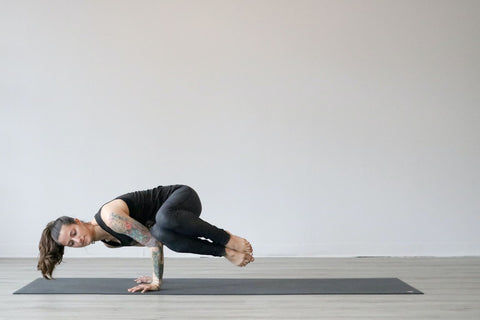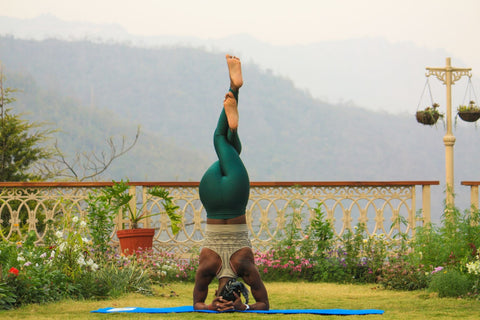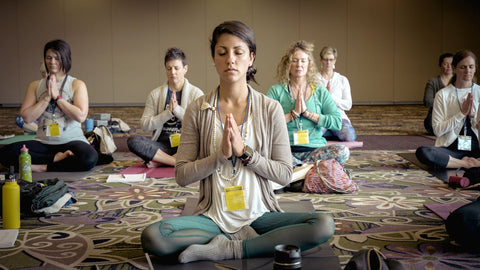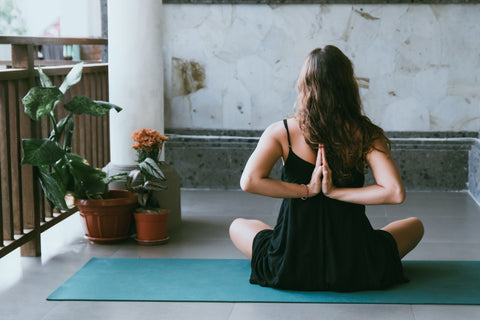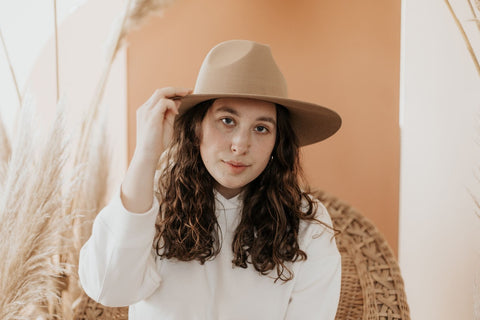The practice of yoga can improve so many aspects of someone’s life no matter the stage of their journey. But many people miss out on the healing qualities of yoga simply because they feel they cannot do the poses. Luckily for us, the practice of yoga has evolved over the years and many yoga styles offer great modifications to help our body feel the benefits of yoga.
The best way to make yoga accessible for everyone is with the use of yoga props. B.K.S. Iyengar, the founder of Iyengar Yoga is often credited with bringing the use of yoga props into the yoga room. His use of yoga blocks, yoga straps, chairs, blankets and more help students to not only feel proper alignment in their body, but to help those with physical limitations feel the benefits of the pose as well.
The use of props have now made their way into most yoga studios and many teachers use them in every class. The use of a prop is not just for beginner yogis, seasoned yogis use them as well to continue to explore their practice and gain deeper awareness of their body. It is important to emphasize to yogis that using a block does not show weakness or inexperience, in fact it shows a stronger yoga practice.
If you or someone you know would like to begin a yoga practice but feel your body needs an assist to practice many of the poses, then we’ve got you covered. Below you will find five common yoga poses and how to use yoga props to modify each pose. Remember, the practice of yoga is just that, a practice. So the more you take the time to practice these poses, the faster your body will positively respond.
Check out how to modify these five common yoga poses to help your yoga practice:
Lunge
You can practice a few variations of Lunge in your yoga practice and each variations is great to stretch your hips and quadriceps as well as build strength and balance. But many of us are extremely tight in our hips and holding a Lunge can be more painful than beneficial. To make Lunge more accessible, we can use blocks to assist with our balance and to help safely stretch your hips and quadriceps.
Let’s try it:
- Place two blocks at the top of your yoga mat
- Begin in Downward Facing Dog
- Inhale to bring your right foot forward for your Lunge
- Choose which block height works best for you, then frame your right foot with your blocks
- Option to drop the back knee or keep it lifted
- Remain here for a few breaths then switch sides
How do the blocks help?
The blocks will give you the extra height needed to allow your body to slowly stretch. For many yogis, placing the hands on the ground in a Lunge is too intense. The blocks will also give an assist to strengthening your inner thighs while you engage them toward the midline to work the balance in this pose. The blocks have three height variations to help accommodate many levels and progressions for each yogi.
Seated Forward Fold
A Seated Forward Fold is an amazing posture to help stretch not only your hamstrings, but your back and neck as well. Many beginner yogis are focused on grabbing their feet in this pose in hopes of getting the best stretch. But grabbing your feet is not necessary to feel the benefits and it is not accessible to everyone. So now it is time to grab your yoga strap, blanket or a yoga block to practice a few variations to help you gain the most benefit.
Let’s try variation #1:
- Begin seated on your yoga mat with your legs extended and your yoga strap in hand
- Inhale and lengthen your spine by reaching your chest up and exhale to slowly fold over your legs
- Be sure your spine stays long as you slowly fold by reaching your heart forward
- Once you find your edge, place the strap on the balls of your feet
- The tails of the strap should be long enough to keep your arms from reaching and your back rounded
- Remain here and continue to use your breath to slowly invite more opening in the body
- Slowly come back to seated
Let’s try variation #2:
- Grab a yoga block or folded blanket
- Place your prop at the back of your mat and have a seat on your chosen yoga prop
- Extend your legs in front of you
- Use the same prep work and breath work as above to practice this variation of your Seated Forward Fold
- Remain for a few breaths then slowly come back to seated
How do the props help?
In the first variation, the strap acts as an extension of our arms. When we practice this fold, our intention is to keep our back straight and our elbows by our side. The extra length of the strap helps us keep the integrity of the pose and keeps us from forcing something our body isn’t ready to practice.
The second variation uses a yoga block or blanket to elevate your hips. This simple modification eases the pressure and tension off your low back and hamstrings. With the hips high in this pose, the body is able to fold more easily and you may have the opportunity to work your belly toward your thighs.
Triangle Pose
Triangle Pose offers a great hip and hamstring opener along with a twist. When we practice Triangle Pose, we are working toward an open heart as well. Many of us will discover just how tight our hips and hamstrings are when we come into this pose. And sometimes, placing our hand on the ground or on our shin still leaves us in discomfort. A yoga block is the perfect modification to allow our body to benefit from Triangle Pose.
Let’s try it:
- Place your yoga block at the top of your mat
- Begin in Warrior II
- Inhale, then slowly straighten your front leg and lengthen your spine
- Exhale and reach your front arm forward while keeping your hips and heart open
- Once you find your ready to hinge in your Triangle Pose, grab your yoga block and place it next to your front foot
- Find which height works best for you to allow your heart, hips and hamstrings to open
- Remain in your Triangle Pose for a few breaths, then switch sides
How does the block help?
Again, Triangle Pose is a great twist as well as hip and hamstring stretch. When we practice twisting, we always want our spine to be long before we twist. When we place our bottom hand on the block we give our spine the extra space needed for a healthy twist. With your heart open from the healthy twist, your hips and hamstring can also benefit from a healthy stretch.
Plus, if students lack the core strength to keep their torso lifted in Triangle Pose, many will place too much pressure on the bottom leg with their hand. By placing their bottom hand on the block, they can build strength in their core without straining their knee joint.
Dancer’s Pose
Dancer’s Pose will work your balance, flexibility and strength in one posture. When a pose is as intricate as Dancer’s Pose, many yogis find it more accesible to work on one aspect of the pose at a time. Keeping your balance while working the standing backbend and shoulder opener can be quite intense. But a strap is a very helpful tool to find more accessibility in this pose.
Let’s try it:
- Begin standing at the top of your mat with your strap in your right hand
- Ground into your left foot. Then bend your right knee and lift your right foot
- Place the strap around your right foot. Leave an equal amount of tail of the strap on both sides of the foot. Then bring your hips and shoulders square to the top of your mat
- Inhale your left arm up and on your exhale slowly begin to kick your right foot into the strap
- With each inhale create length in your spine and with each exhale work your backbend
- When you’re ready, slowly release the strap and bring your right foot to the ground
- Be sure to practice the other side
How does the strap help?
The strap again acts as a longer variation of your arm. The backbend we practice in Dancer’s Pose is often an intense backbend for many of us. So the extra space provided by the strap helps our body slowly find the backbend. Without having to strain to find the backbend, we can focus more on our balance and alignment.
Pigeon Pose
Pigeon Pose is a yoga pose that many yogis either love or hate. Pigeon Pose asks us to remain in this intense hip opener and to focus on our breath.The benefits of this hip opener are incredible and so is the time spent working through any emotions that arise. A yoga block or folded blanket will help you find a modification in Pigeon Pose that will help your yoga practice tremendously.
Let’s try it:
- Place your block or folded blanket at the top of your mat
- From your Downward Facing Dog, place your right knee behind your right wrist and your right foot across your mat
- For a less intense hip opener, bring your right foot toward the midline
- Square your hips by drawing your left hip forward. Notice if your right hip is off of the ground
- Grab your yoga prop and place it under your right hip, this will allow you to relax your hips and still keep them square
- Inhale, then lift your chest and exhale place your palms on the ground, forearms on a prop or on the ground and stay in your Pigeon Pose for at least 10 breaths
- When you’re ready to release, come back to Downward Facing Dog
- Be sure to practice both sides
How does the yoga prop help?
It is important to keep the hips square in Pigeon Pose so the sacrum is not turned and no added strain placed on the low back. Plus, this modification also gives your body a chance to fully relax in this pose, which is the best way to feel the full benefits.
These are just a few ways to use your yoga props to help you get started with yoga or to even deepen your yoga practice. Much of our focus in yoga is letting go of expectations and being present with where we are now in our journey. If you know you would benefit from adding a few of these props into your poses, go for it! Your body and yoga practice will feel the benefits.
About the Author

Michelle is a YogaClub Tribe Leader living the yoga mom life and loving every second. She believes all beings deserve joy, peace and love and aims to be an example. She is forever grateful for her yoga practice and her opportunity to share this joy as a yoga and Buti Yoga instructor.







